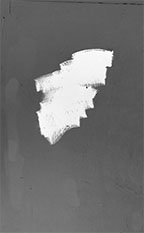Problem: Create black & white figure-ground (obvious and ambiguous) compositions based on the simplified forms created from photographs of discarded objects found on an urban sidewalk, wall, ceiling, etc.
Limits: Simple, flat, black shapes, NO lines or text.
Materials: Sketchbook, camera/phone, pencils, ruler/ t-square, eraser, artist tape.
Concepts: Shape (Organic, Geometric), Frame, Figure-Ground (Obvious, Ambiguous), Unity, Economy, Simplicity.
Technical Skills: Thumbnail sketching, digital imaging, drafting with ruler/t-square, inking pens.
Design Process:
- Step 1: Discover
- Step 2: Define
- Step 3: Develop
- Step 4: Deliver
Step 1: Discover
Take a walk.
Along the way you will be looking for small objects — left over items, objects or fragments of objects that have been discarded, lost, deteriorated or destroyed.
Take 6 black and white photographs:
-
- 3 Photographs should demonstrate an obvious figure/ground relationship. See example below.
- 3 Photographs should demonstrate an ambiguous figure/ground relationship. See example below.
 Ambiguous figure/ground example
Ambiguous figure/ground example
Writing
- Look at the images of the objects you discovered on your walk.
- Think about the history of each object; the shape, the texture, how it ended up where it did.
- Make sure to note the identity and location of the objects you photograph.
Post to the Class Blog:
- Under Categories (on right hand side), choose “Project 1- Lost & Found” “Step 1: Discover”. Post your images.
- Upload the six images of the objects you discovered on your walk. Name them accordingly, “obvious or ambiguous”.
- Include the information about objects’ location and identity.
Step 2: Define
Goal: Develop an understanding of the two types of figure-ground relationships, obvious and ambiguous.
Through experimentation and repetition create six compositions using pencil and paper, based on your original photographic compositions of urban objects.
Review Principles:
- Composition: The formal organization of elements in a composition arranged according to principles that will support the communication of the concept.
- Organic shape: Is one that resembles the flowing contours of an organism.
- Geometric shape: such as circles, triangles or squares often have precise, uniform measurements.
- Figure (positive space): The shape of a form that serves as a subject in a composition.
- Ground (negative space): The space surrounding a positive shape or form; sometimes referred to as ground, empty space, field, or void.
- Figure/Ground: The relationship between positive and negative space.
-
- OBVIOUS: An obvious figure-ground will generally have an imbalance of figure and ground (30/70), wherein the ground “supports” or surrounds the figure.
-
- AMBIGUOUS: An ambiguous figure-ground will generally have a closer balance of figure and ground (50/50), wherein the differentiation between figure and ground become blurred. Often the figure will intersect the boundaries of the frame.
STUDENT EXAMPLES: Can you determine which image demonstrates Obvious and Ambiguous Figure/Ground? And why? Are they all successful or could some be improved? How? Example 1 I Example 2
Sketch
Sketches are used to explore layout options. These quick drawings allow the designer to try out a range of ideas and find the best compositions before beginning a project.
Working from your black and white printed photographs, you will complete a minimum of:
- 3 Obvious figure-ground compositions
- 3 Ambiguous figure-ground compositions
- Create new compositions based on your urban objects.
- Using an hb-2b pencil and tracing paper, trace and/or re draw actual size compositions in your sketchbook.
- Adjust the placement until the arrangements feel unified. In some instances, you may need to simplify, removing some elements in order to create a more unified composition.
- Observe the objects (figure) and the background layer (ground). Are the figure and ground present in equal proportions or unequal? How do they relate? Does the ground support the figure or fight for dominance?
Step 3: Final Sketches Choose your best obvious and best ambiguous figure-ground sketches and refine.
- Use a full page in your sketchbook to redraw and refine each of your compositions.
NOTE: Adjust the orientation of the page (portrait or landscape), as needed, but consider choosing the same orientation for both compositions.
- There should be a clear transition from the photographs > to the thumbnails sketches > to the refined final sketches.
- When you are finished, take a photograph of your thumbnails and each refined sketch.
Documentation and Feedback
- Under Categories (on right hand side), choose “Project 1- Lost & Found” “Step 3: Final Sketches” and post photographs of your two finished drawings, along with your six rough sketches.
This project is originally designed by Jenna Spevack. This version was revised by Paula Rennis, then further adapted by Jake Wright.
 Obvious figure/ground example
Obvious figure/ground example


